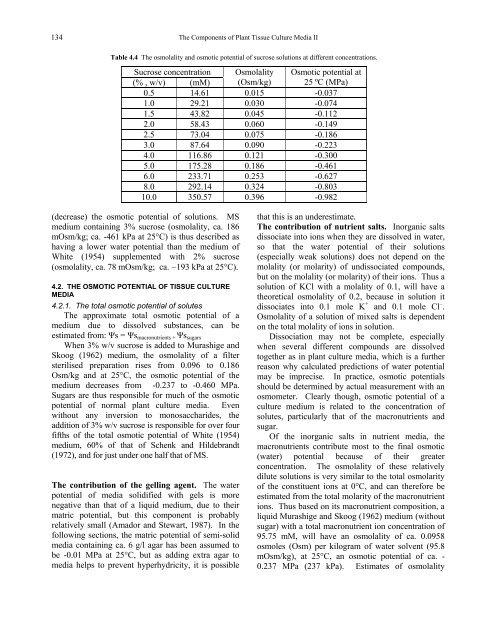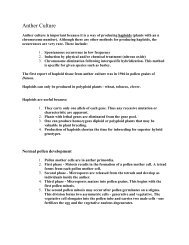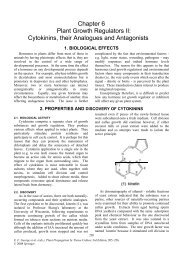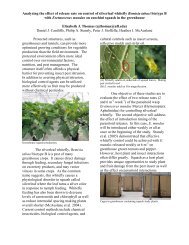The Components of Plant Tissue Culture Media II - Horticultural ...
The Components of Plant Tissue Culture Media II - Horticultural ...
The Components of Plant Tissue Culture Media II - Horticultural ...
Create successful ePaper yourself
Turn your PDF publications into a flip-book with our unique Google optimized e-Paper software.
134 <strong>The</strong> <strong>Components</strong> <strong>of</strong> <strong>Plant</strong> <strong>Tissue</strong> <strong>Culture</strong> <strong>Media</strong> <strong>II</strong><br />
Table 4.4 <strong>The</strong> osmolality and osmotic potential <strong>of</strong> sucrose solutions at different concentrations.<br />
Sucrose concentration Osmolality Osmotic potential at<br />
(% , w/v) (mM) (Osm/kg) 25 ºC (MPa)<br />
0.5 14.61 0.015 -0.037<br />
1.0 29.21 0.030 -0.074<br />
1.5 43.82 0.045 -0.112<br />
2.0 58.43 0.060 -0.149<br />
2.5 73.04 0.075 -0.186<br />
3.0 87.64 0.090 -0.223<br />
4.0 116.86 0.121 -0.300<br />
5.0 175.28 0.186 -0.461<br />
6.0 233.71 0.253 -0.627<br />
8.0 292.14 0.324 -0.803<br />
10.0 350.57 0.396 -0.982<br />
(decrease) the osmotic potential <strong>of</strong> solutions. MS<br />
medium containing 3% sucrose (osmolality, ca. 186<br />
mOsm/kg; ca. -461 kPa at 25°C) is thus described as<br />
having a lower water potential than the medium <strong>of</strong><br />
White (1954) supplemented with 2% sucrose<br />
(osmolality, ca. 78 mOsm/kg; ca. −193 kPa at 25°C).<br />
4.2. THE OSMOTIC POTENTIAL OF TISSUE CULTURE<br />
MEDIA<br />
4.2.1. <strong>The</strong> total osmotic potential <strong>of</strong> solutes<br />
<strong>The</strong> approximate total osmotic potential <strong>of</strong> a<br />
medium due to dissolved substances, can be<br />
estimated from: Ψs = Ψsmacronutrients + Ψssugars<br />
When 3% w/v sucrose is added to Murashige and<br />
Skoog (1962) medium, the osmolality <strong>of</strong> a filter<br />
sterilised preparation rises from 0.096 to 0.186<br />
Osm/kg and at 25°C, the osmotic potential <strong>of</strong> the<br />
medium decreases from -0.237 to -0.460 MPa.<br />
Sugars are thus responsible for much <strong>of</strong> the osmotic<br />
potential <strong>of</strong> normal plant culture media. Even<br />
without any inversion to monosaccharides, the<br />
addition <strong>of</strong> 3% w/v sucrose is responsible for over four<br />
fifths <strong>of</strong> the total osmotic potential <strong>of</strong> White (1954)<br />
medium, 60% <strong>of</strong> that <strong>of</strong> Schenk and Hildebrandt<br />
(1972), and for just under one half that <strong>of</strong> MS.<br />
<strong>The</strong> contribution <strong>of</strong> the gelling agent. <strong>The</strong> water<br />
potential <strong>of</strong> media solidified with gels is more<br />
negative than that <strong>of</strong> a liquid medium, due to their<br />
matric potential, but this component is probably<br />
relatively small (Amador and Stewart, 1987). In the<br />
following sections, the matric potential <strong>of</strong> semi-solid<br />
media containing ca. 6 g/l agar has been assumed to<br />
be -0.01 MPa at 25°C, but as adding extra agar to<br />
media helps to prevent hyperhydricity, it is possible<br />
that this is an underestimate.<br />
<strong>The</strong> contribution <strong>of</strong> nutrient salts. Inorganic salts<br />
dissociate into ions when they are dissolved in water,<br />
so that the water potential <strong>of</strong> their solutions<br />
(especially weak solutions) does not depend on the<br />
molality (or molarity) <strong>of</strong> undissociated compounds,<br />
but on the molality (or molarity) <strong>of</strong> their ions. Thus a<br />
solution <strong>of</strong> KCl with a molality <strong>of</strong> 0.1, will have a<br />
theoretical osmolality <strong>of</strong> 0.2, because in solution it<br />
dissociates into 0.1 mole K + and 0.1 mole Cl – .<br />
Osmolality <strong>of</strong> a solution <strong>of</strong> mixed salts is dependent<br />
on the total molality <strong>of</strong> ions in solution.<br />
Dissociation may not be complete, especially<br />
when several different compounds are dissolved<br />
together as in plant culture media, which is a further<br />
reason why calculated predictions <strong>of</strong> water potential<br />
may be imprecise. In practice, osmotic potentials<br />
should be determined by actual measurement with an<br />
osmometer. Clearly though, osmotic potential <strong>of</strong> a<br />
culture medium is related to the concentration <strong>of</strong><br />
solutes, particularly that <strong>of</strong> the macronutrients and<br />
sugar.<br />
Of the inorganic salts in nutrient media, the<br />
macronutrients contribute most to the final osmotic<br />
(water) potential because <strong>of</strong> their greater<br />
concentration. <strong>The</strong> osmolality <strong>of</strong> these relatively<br />
dilute solutions is very similar to the total osmolarity<br />
<strong>of</strong> the constituent ions at 0°C, and can therefore be<br />
estimated from the total molarity <strong>of</strong> the macronutrient<br />
ions. Thus based on its macronutrient composition, a<br />
liquid Murashige and Skoog (1962) medium (without<br />
sugar) with a total macronutrient ion concentration <strong>of</strong><br />
95.75 mM, will have an osmolality <strong>of</strong> ca. 0.0958<br />
osmoles (Osm) per kilogram <strong>of</strong> water solvent (95.8<br />
mOsm/kg), at 25°C, an osmotic potential <strong>of</strong> ca. -<br />
0.237 MPa (237 kPa). Estimates <strong>of</strong> osmolality






